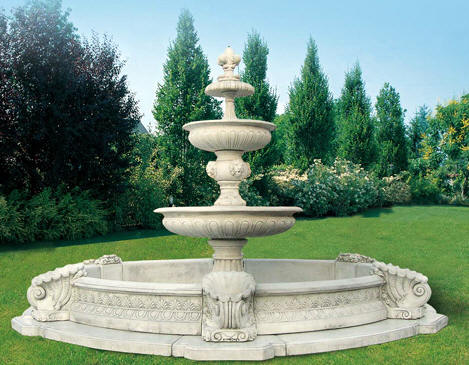Frequently Asked Indoor, Outdoor, and Wall Fountain Questions
Below you will find some commonly asked questions by our customers regarding indoor and outdoor water fountains. If you don’t see a question below that relates to yours, or you can Contact Us and we will be happy to help!

Q: What is this white stuff that is forming on my water fountain?
A: If you are using hard water as opposed to distilled water, this is called White Scale, or Lime Deposits. It is caused by chemicals in hard tap water, and usually forms along where the water sits on the fountain. White Scale deposits can be stubborn to remove but you can use CLR (calcium lime remover) commonly found in a hardware or discount store, or a mixture of vinegar and water. To prevent hard water stains (white scale).
Q: Why does my fountain smell?
A: The most common reason for an odor coming from your water fountain is that it needs to be cleaned. It probably has algae growing in it. Although water fountains are fairly low maintenance, they need to be cleaned regularly to avoid algae growth which leads to a smelly water fountain. Read our Water Fountain Cleaning Guide for more on cleaning water fountains. You can also purchase one of many fountain care products to prevent and prolong algae build up in your fountains. This does not make cleaning unnecessary but you may be able to go longer between cleanings. You should be completely emptying and cleaning your water fountain every 2-4 months. I think more often is better if you have a smaller tabletop fountain that is easy to clean.
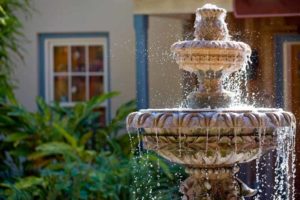
Q: My water fountain is making a spitting sound and not pumping water very well, or running very loudly, what is wrong with it?
A: This is most likely a sign that there is not enough water in your fountain. Depending on the humidity level in the air, your fountain may need to be filled as often as every day, or as little as once a week. Be sure your indoor and outdoor fountains have enough water to cover the entire pump, best to even be sure there is 2 inches of water over the fountain’s pump.
If adding water did not help, another factor to consider is that the pump may not be positioned properly causing it to vibrate. If your fountain has suction cups, you can use them to position your pump securely or use foam strips. You can also use a scotch bride pad or other type of sponge tied around the pump to keep from vibrating.
If none of the above works, and your pump is still performing poorly, it could be that it is dirty, clogged, or has mineral deposits inside. Remove the pump and clean it. Also, keep in mind that fountain pumps are actually designed to run 24/7, so turning them on and off a lot is hard on the pump, and will decrease the life of your pump.
Q: My water fountain is splashing, is this normal?
A: Depending on the type of fountain you purchased, this may or may not be normal. Most fountains that are designed for outdoor use may splash some, but indoor fountains are engineered not to splash. If you experience splashing, a few things you can check are the water level, pump speed, and the positioning of any rocks or splash guards.
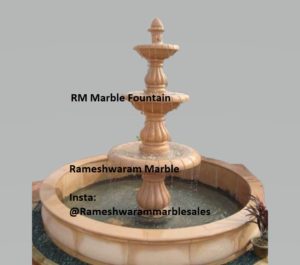
If the water level of your fountain is too low, and the pump is exposed, the pump will take in air and cause a spitting/splashing effect. Most fountain pumps have an adjustable flow control. Check this as you may have yours set too high for your particular fountain, which would cause the water to come out too quickly and cause splashing. If you have rocks in the basin of your fountain, the water could be bouncing off the rocks. Try to rearrange the rocks for a better flow into the base of your fountain. One other tip, if you are using a outdoor style waterfall indoors, you may want to cut a screen to place in the basin so that once the water falls into the basin it will not bounce back out and onto the floor.
Q: What do I do in the winter months with my outdoor fountain?
A: If you live in a climate where the temperature gets below freezing in the winter, you will either need to bring your outdoor fountain in or completely drain and cover it. Water can not stay in your fountains and be allowed to freeze. The freezing and thawing of water inside your water feature could cause the fountain to crack. If the fountain pump is allowed to sit in the fountain in ice this could cause pump damage as well. Fountain covers work exceptionally well and will protect your fountain. No matter what you plan to do with your fountain in the winter months it must be drained completely and dried out.
Trouble Shooting Guide for Wall Fountains
In addition to all the troubleshooting above, wall fountains sometimes require a little extra maintenance and care. Each engineers wall fountains designs can vary so these are basic tips. Your wall fountain should have come with a troubleshooting guide as well. Below are some common troubleshooting tips for wall fountains.
Q: My water is not flowing down the whole face of the fountain; how can I fix that?
A: This is common in wall fountains especially if they are started and stopped frequently. Typically it is just a matter of starting the water flow and then it will follow its own path continuously. If you have checked the pump pressure to be sure it is turned up, and you know that your distribution unit or pump is clean, try the following steps:
Take a non-scratch scouring pad and rub it along the water distribution unit of the fountain. If you have a slate-faced wall fountain, you may notice that some parts of the slate are restricting the water flow, you can use the non-scratch scouring pad on the slate face. Please note that if you have a logo DO NOT use a scouring pad on it. If you have a glass face fountain, the first step is to thoroughly clean the glass. To clean the glass you can use a glass cleaner .Next, you will likely have to “start” the water flow. You can do this by tracing your finger or an eraser or sponge where the water is stopping and drag it to get the water flowing. Again, once you do this the water will follow that path.
Another thing to check is the mounting bracket. Check to make sure it is level. A level wall fountain is critical for proper function.
Any blockages in the distribution unit of the fountain can also inhibit water flow. A small paper clip or toothbrush can remove that.
Some wall fountains or waterfalls have a “lip or tray on top that the water flows over. You can get the water to flow over that by rubbing your finger along the top.
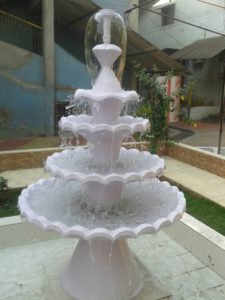
Q: Why is the water flow of my wall fountain too slow/fast?
A: Your flow valve or pump setting may not be right for your fountain. Most pumps will have an adjustable flow valve or a adjustable dial on the pump. Try different settings here. If you have a pump that is not adjustable and your water is flowing too fast you can clamp the hose with a clip to restrict some of the water flow. As always, be sure you have enough water in the fountain.
Q: Why is my fountain leaking?
A: This is typically caused by over-filling the wall fountain. Most wall fountains have a tray inside the water basin that holds water. If water gets outside this tray or if the tray is overfilled it may leak out the bottom making it appear that the fountain is leaking. Remove some of the water and dry out the outer areas to see if this solves the problem. Honestly, other than the fountain being damaged in transit, there really is nothing that can “leak” in most wall fountain styles.
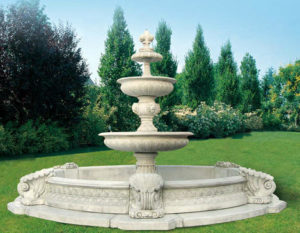
Q: Why does my wall fountain have dirty water, algae or white scale?
A: This is a sign that it is time to clean your wall feature! No wall fountain is maintenance-free. Anywhere there is water, algae will grow over time. See our complete Wall Fountain Cleaning Guide. You may also find some of the fountain care products helpful in prolonging algae growth and white scale build up.
We hope this helps you with your water fountain troubleshooting. We would be happy to help you if there are questions that are not answered above.



